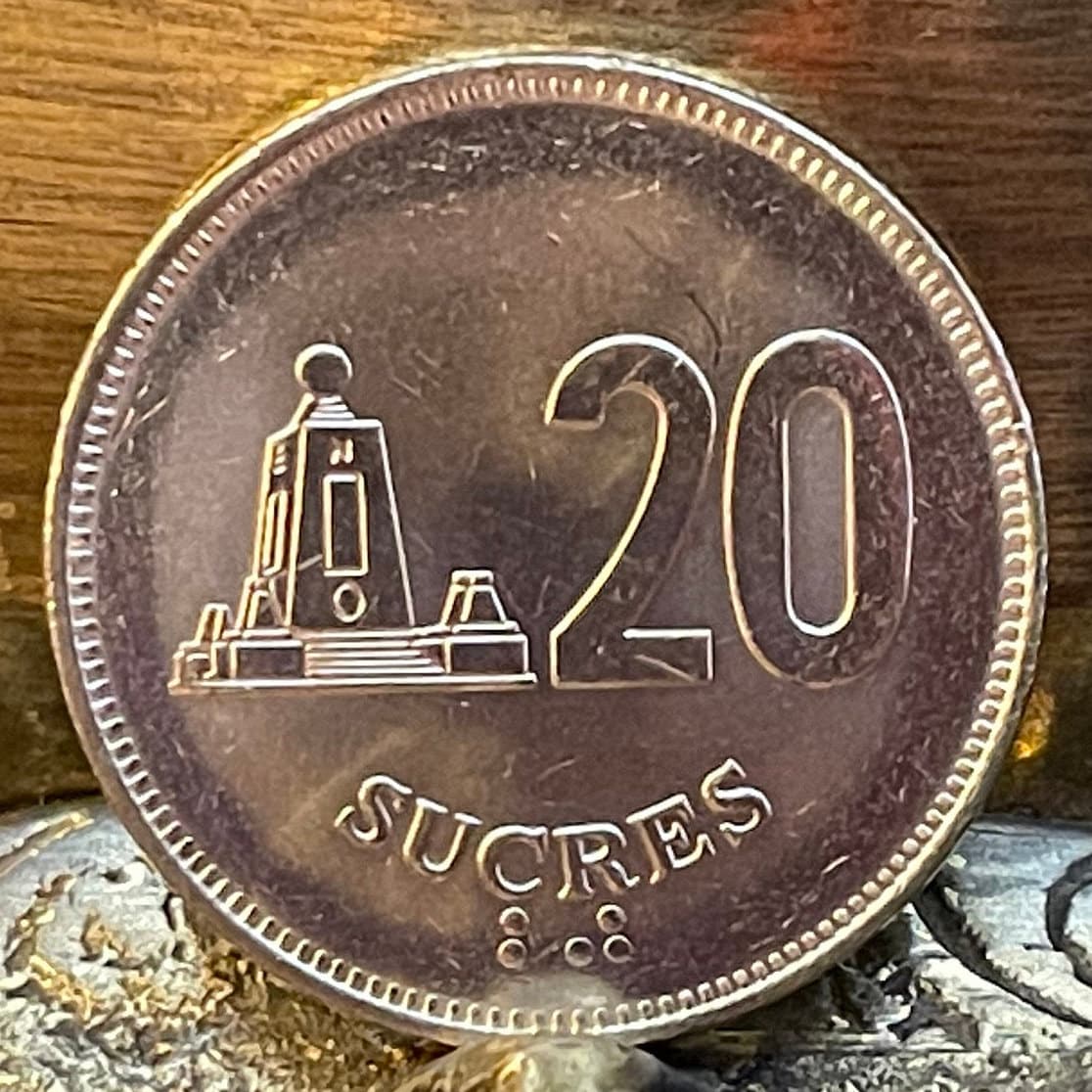elemintalshop
Monument to the Equator 20 Sucres Ecuador Authentic Coin Money for Jewelry and Craft Making (Middle of the World City) (Mitad del Mundo)
Monument to the Equator 20 Sucres Ecuador Authentic Coin Money for Jewelry and Craft Making (Middle of the World City) (Mitad del Mundo)
Couldn't load pickup availability
Monument to the Equator 20 Sucres Ecuador Authentic Coin Money for Jewelry and Craft Making (Middle of the World City) (Ciudad Mitad del Mundo)
Obverse: Name of the country, coat of arms, year of issue
Lettering: REPUBLICA DEL ECUADOR
Translation: Republic of Ecuador
Reverse: Denomination in digits, denomination in Braille, an image of the Monument to the Equator, in Ciudad Mitad del Mundo" ("Middle of the World City") at the equatorial line (near Quito)
Lettering: 20 SUCRES
Features
Issuer Ecuador
Period Republic (1830-date)
Type Standard circulation coin
Years 1988-1991
Value 20 Sucres (20 ECS)
Currency Sucre (1884-2000)
Composition Nickel clad steel
Weight 8.3 g
Diameter 26.0 mm
Thickness 2.3 mm
Shape Round
Technique Milled
Orientation Coin alignment ↑↓
Demonetized 9 October 2000
Number N# 1768
References KM# 94, Schön# 87
Wikipedia:
The Ciudad Mitad del Mundo (Middle of the World City) is a tract of land owned by the prefecture of the province of Pichincha, Ecuador. It is located at San Antonio parish of the canton of Quito, 26 km (16 mi) north of the center of Quito. The grounds contain the Monument to the Equator, which highlights the exact location of the Equator (from which the country takes its name) and commemorates the eighteenth century Franco-Spanish Geodesic Mission which fixed its approximate location; they also contain the Museo Etnográfico Mitad del Mundo, Ethnographic Museum Middle of the Earth, a museum about the indigenous people ethnography of Ecuador.
The 30-metre-tall (98 ft) monument was constructed between 1979 and 1982 by Pichincha's Province Council to replace an older, smaller monument built by the Government of Ecuador under the direction of the geographer Luis Tufiño in 1936. It is made of iron and concrete and covered with cut and polished andesite stone. The monument was built to commemorate the first Geodesic Mission of the French Academy of Sciences, led by Louis Godin, Pierre Bouguer and Charles Marie de La Condamine, who, in the year 1736, conducted experiments to test the flattening at the poles of the characteristic shape of the Earth, by comparing the distance between a degree meridian in the equatorial zone to another level measured in Sweden. The older monument was moved 7 km (4.3 mi) to a small town near there called Calacalí. The UNASUR former headquarters is located in this place, but is now in disuse following Ecuador's withdrawal from the organization in 2019.
Latitude discrepancy
Based on data obtained by Tufiño, it was believed that the equator passed through those two sites. However, according to readings based on the World Geodetic System WGS84, used in modern GPS systems and GIS products, the equator actually lies about 240 metres (790 ft) north of the marked line.
Over the years, countless tourists have had their pictures taken straddling the line drawn down the center of the east-facing staircase and across the plaza.
The pyramidal monument, with each side facing a cardinal direction is topped by a globe which is 4.5 metres (15 ft) in diameter and weighs 5 tonnes (4.9 long tons; 5.5 short tons). Inside the monument is a small museum that displays a variety of indigenous items pertaining to Ecuadorian culture: clothing, descriptions of the various ethnic groups, and examples of their activities.
Ciudad Mitad del Mundo contains other attractions such as a planetarium, a miniature model of Quito, and restaurants. On weekends, Ciudad Mitad del Mundo's Central Plaza hosts varied musical and cultural events for tourists. Also, there are diverse local handcraft stores and local food served at several cafés along a colonial small town.
******
Wikipedia:
Ecuadorian law describes the arms as follows:
The Arms of Ecuador shall be an oval shield containing inside, in the upper part the sun with the part of the Zodiac where one finds the signs corresponding to the memorable months of March, April, May and June; in the lower part, to the right shall be represented the historical mountain Chimborazo, wherefrom shall start a river, and where it appears most abundant shall be a steamship, having for a mast a caduceus, as a symbol of navigation and commerce. The shield shall rest on a bundle of consular beams, a symbol of the republican dignity. It shall be adorned on the outside with national flags and branches of palm and laurel, and surmounted by a condor with wings displayed.
History
The shield was introduced after the victory of the liberal revolution of 1845, but then flanked by white-blue-white flags; which were then replaced in the reintroduction of the Tricolor flags. The coat of arms in its current form was approved by congress on October 31, 1900.
Share



















